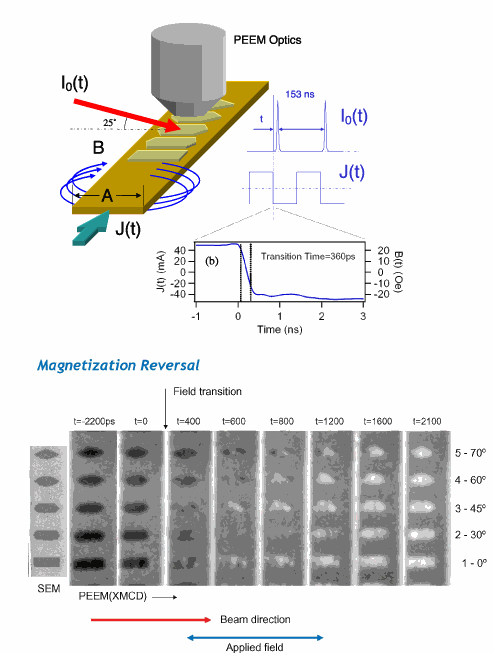The dynamics of nanoscale magnetic structures are of both fundamental interest and primary importance for the development of new high-speed electronic devices that incorporate nanomagnets. Magnetic random access memory (MRAM), for example, could enable “instant-on” computers that would not require booting each time the power is cycled. There are many unresolved questions, however, concerning how the shape of a nanostructure affects the magnetization reversal process. A clear understanding of this reversal mechanism is essential, since this is the process by which information (in the form of bits) is written on the magnetic materials used in computer data storage. One of the principal questions yet to be understood is how and on what time scale magnetization reverses in patterned structures. Time-resolved magnetic domain imaging of the intermediate states during reversal is critical to understanging how competing energies work in such nanoscale structures and how their effects influence the reversal process.
Researchers from Argonne, Katholieke Universiteit Leuven, and Universitat Autonoma de Barcelona, using the X-ray Operations and Research beamline 4-ID-C at the Argonne Advanced Photon Source, have employed time-resolved photoemission electron microscopy (PEEM) to image—with <100 ps resolution—magnetic reversal in a series of tapered permalloy (Ni80 Fe20), needle-like dots with different end shapes. The end shape of the structures was found to have a strong effect on the reversal mechanism, with a corresponding impact on the magnetic fields needed and the time required for switching.
Reversal in needles with rectangular ends occurred via the nucleation and growth of multiple magnetized regions (domains) throughout the structure. In those needles with tapered ends, on the other hand, the reversal began from a single domain at the structure center and moved towards the needle ends with increasing time. Theoretical models can be used to predict a crossover in the magnetic stability of the structure as the angle of the end taper is increased.
These results show that subtle variations in shape can be used to tailor the properties of magnetic nanostructures.
Contact: D. Keavney [email protected]
See: X.F. Han, M. Grimsditch, J. Meersschaut, A. Hoffmann, Y. Ji, J. Sort, J. Nogues, R. Divan, J.E. Pearson, and D.J. Keavney, “ Magnetic Instability Regions in Patterned Structures: Influence of Element Shape on Magnetization Reversal Dynamics,” Phys. Rev. Lett. 98, 147202 (2007) . DOI: 10.1103/PhysRevLett.98.147202
Work at Argonne National Laboratory and the Advanced Photon Source was supported by the U.S. Department of Energy, Office of Science, Office of Basic Energy Sciences under Contract No. DE-AC02-06CH11357. Work at Universitat Autonoma de Barcelona was supported by the No. 2005SGR-00401, the No. MAT-2004-01679 research projects, and the Institut Catala de Nanotecnologia (ICN).
Argonne is a U.S. Department of Energy laboratory managed by UChicago Argonne, LLC

